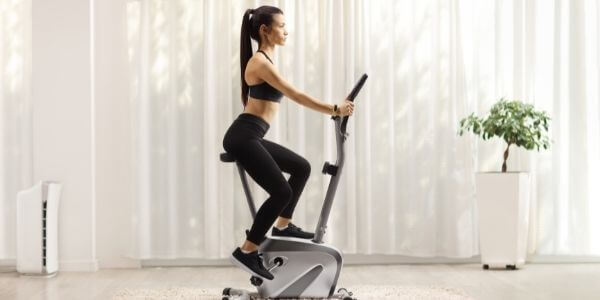Some physiotherapists recommend cycling for injury rehab, while others maintain that exercise bikes are bad for your knees. Even more confusingly, both statements have scientific support.
So, can riding a stationary bike hurt your knees?
Read the article below as we explore this apparent contradiction and help you find the best indoor bike for knee pain.
Table of Contents
Can Exercise Bikes Damage Your Knee?
The short answer is yes; an exercise bike can damage your knee if you’re not using it correctly.
Firstly, you should know that knee injury implies weakening in your muscles, tendons, or ligaments around the knee. As a result, your joints become unstable.
“Cyclist’s knee” is an excellent example.
This condition is caused by overusing your joint while pedaling. The excessive friction between the knee cap and your thigh bone damages your joint, causing it to hurt.
Thus, knee pain often happens when you try to ride your bike for longer, faster, and more intensely than you usually do.
Besides, stationary bikes are low-impact – but not zero-impact.

If your knees are bothering you or have any preexisting musculoskeletal conditions, choose the lowest-impact stationary bike from the bunch:
- Recumbent bikes are the easiest on your knees from the bunch because you’re sitting down with your legs stretched in front of you. As a result, your knees take less pressure from your body.
Related: 8 Recumbent Bike Benefits And 3 Disadvantages
- Upright bikes are knee-friendly, too, because you can select your speed and resistance. As such, you can pedal fast but at low resistance to work on your cardio without damaging your knee. Of course, if you have mobility issues, you can pedal at a low-speed setting too.
- Air bikes aren’t 100% knee-friendly because their resistance increases when you pedal faster. That’s a problem if you have knee pain or simply want to work on your cardio first. So, unless you’re pedaling at low speeds and low resistances, air bikes aren’t that good for knees.
Related: Air Bike Benefits: The Good, The Bad, And The Risky
- Spin bikes are the riskiest and least indicated for people with knee pain. Their narrow seats and standing workouts put more pressure on your knee caps than the other models above.
Can Stationary Bikes Hurt Your Knees?
Some stationary bikes are hard on the knees because of their design. But it’s more than that; sometimes, people don’t know how to adjust their indoor bikes correctly, which causes knee pain.
Here’s what you’ll have to consider:
Adjust Your Seat Correctly
- When the seat is very low, your knees can’t extend correctly and take more pressure. In this case, you’ll feel pain in the front of your knees.
- When your seat is too high, the knees extend too much, damaging the ligaments and tendons. In this case, you’ll feel pain in the back of your knees.
- When your seat is too far back, you will tend to strain forward to push on the pedal. Thus, your knees have to make an additional motion ahead before going downwards. That extra movement wears out your knees.
Pro tip: To avoid all this, ensure your saddle is hip-level and that your legs can extend comfortably without locking. Remember to keep a 90ᵒ angle at your ankle.
Choose the Right Resistance
You should always pick a resistance that challenges you to see fast results. However, few people know that the wrong resistance can cause knee pain.
Here’s how:
- Low resistance causes a lack of control and, therefore, more impact because you’ll push too hard on those pedals. Besides, low resistance makes you jiggle on the bike, which destabilizes your knees.
- High resistance overloads your joints, putting too much pressure on your knees. The rule of thumb for relatively healthy people is choosing a resistance that lets you maintain at least 60 rpm on the bike. Of course, if you’re otherwise mobility-challenged or just recovering from an injury, you can pedal at lower speeds – but you have to feel comfortable.
Pro tip: If you want to avoid knee pain, choose an easily-adjustable bike. Also, avoid air (assault) bikes because you have the least control of their resistance.
Related: 7 Best Exercise Machines for Bad Knees
Is Riding a Stationary Bike Good for Bad Knees?

If all the evidence shows that stationary bikes can damage your knees, how come your physiotherapist recommended you exercise on one?
Let’s explain.
Firstly, we agree that working out a damaged or painful knee can seem counterintuitive. However, not exercising can lead to more pain because of increased stiffness and muscle atrophy.
Imagine the effect that would have on your life.
Of course, not all exercises are recommended for bad knees. The worst of the bunch are based on full-arc knee extensions, such as:
- The full-body gym exercise machine
- Full-depth lunges
- Low squats
- High-impact cardio
- Strength training
- Hurdler’s stretches
As a result, specialists recommend upright bikes for people with arthritis and recumbent bikes for severe pain. The reason is that recumbent cycles put less pressure on your knees and make it easier for you to keep a correct posture on them.
Related: 10 Stationary Bike Benefits and 4 Essential Risks To AVOID
Here’s how an upright or recumbent bike can help your bad knees:
- You strengthen the muscles around your knees (e.g., quads, hamstrings) without excess pressure or flexing your knee joint. In turn, these muscles support and protect your knee caps.
- You protect your knees from the possible impacts that come with cycling outside. For example, you won’t have to deal with bumps and potholes.
- You increase joint mobility and flexibility.
- You strengthen your bones and joints.
Pro tip: Pay attention to your bike’s resistance type too:
- Direct-contact resistance isn’t best if you have knee problems because it’s hiccupy and tough.
- Magnetic resistance is very smooth and easy to adjust, so it’s a good choice for bad knees.
- Air resistance is smooth too, but you can’t adjust it manually. So, the faster you go, the more pressure your knees will have to push through. Fan bikes may be a good choice if:
- You’re okay with starting at low speeds.
- You want to work your way up and improve aerobic capacity and muscle down the line.
How to Protect Your Knees While Indoor Cycling

If you want to protect your knees when cycling indoors:
- First, choose the right bike for your needs. Think of all your health issues, body shape, and goals before you decide.
- Adjust your bike correctly when it arrives, according to your size.
- Warm up thoroughly before beginning your workout.
- Maintain a correct posture, with a straight back and relaxed shoulders. Maintain your knees slightly bent instead of fully extended during your cycling.
- Listen to your body and remember that workouts aren’t punishments. You shouldn’t force yourself to handle resistances, speeds, and distances that trigger pain.
- Execute correct motions. Avoid pushing down and up on those pedals to take more pressure off your knees. Instead, the proper movement is circular; as such, it implies pushing back through your heels to activate your glutes and hamstrings before lifting the foot again.
- Never sacrifice proper form for the sake of other stats.
- If you have preexisting knee pain or are prone to it, avoid spinning.
- Take your time and cool down for at least 5-10 minutes after your workout.
- Take rest days between your sessions. Usually, 24 to 48 hours is enough for your body to recover, but you may need more.
- Strengthen the muscles surrounding your knees. Try strength training, swimming, or plyometrics if your doctor allows you. But remember that some exercises (e.g., full-range squats, deadlifts, lunges) are only recommended to otherwise healthy people.
How to Stop Knees from Hurting
If you experience knee pain, you can try:
- Foam rolling to decrease knee tension and pain. This popular physiotherapy technique aims to stretch the iliotibial band on your thigh.
- Stretching. Some light yoga or Pilates on your rest days can improve mobility, flexibility, and thus, alleviate pain. Watch out, though; some stretches may do more harm than good – for example, overextending inflamed muscles. In this case, some small rotations or massage may be better.
- Compression sleeves. These devices improve blood circulation in the affected area, decrease swelling, and allow your muscles to recover faster.
Warning: Only try these techniques after talking with your GP/physiotherapist to avoid extra injury to those knees.
In Conclusion. Does Exercise Bikes Hurt Your Knees?
Exercise bikes may hurt your knees, but they may also improve knee pain. That’s a contradiction for the ages, but both statements are factual.
To avoid and even improve knee pain, you have to pick the right model for your knees.
Upright and recumbent bikes with magnetic resistance are the best choices. But even within these categories, you’ll find different models, each intended for a specific goal.
So, to avoid making the wrong choice, do some research and find a suitable product for your specific needs.
- 7 Exercises for Pregnant Women in the First Trimester: Safe and Effective - January 30, 2025
- Our equipment recommendations - October 30, 2024
- Here’s What Doing Cardio Every Day Does To Your Body - August 21, 2024

